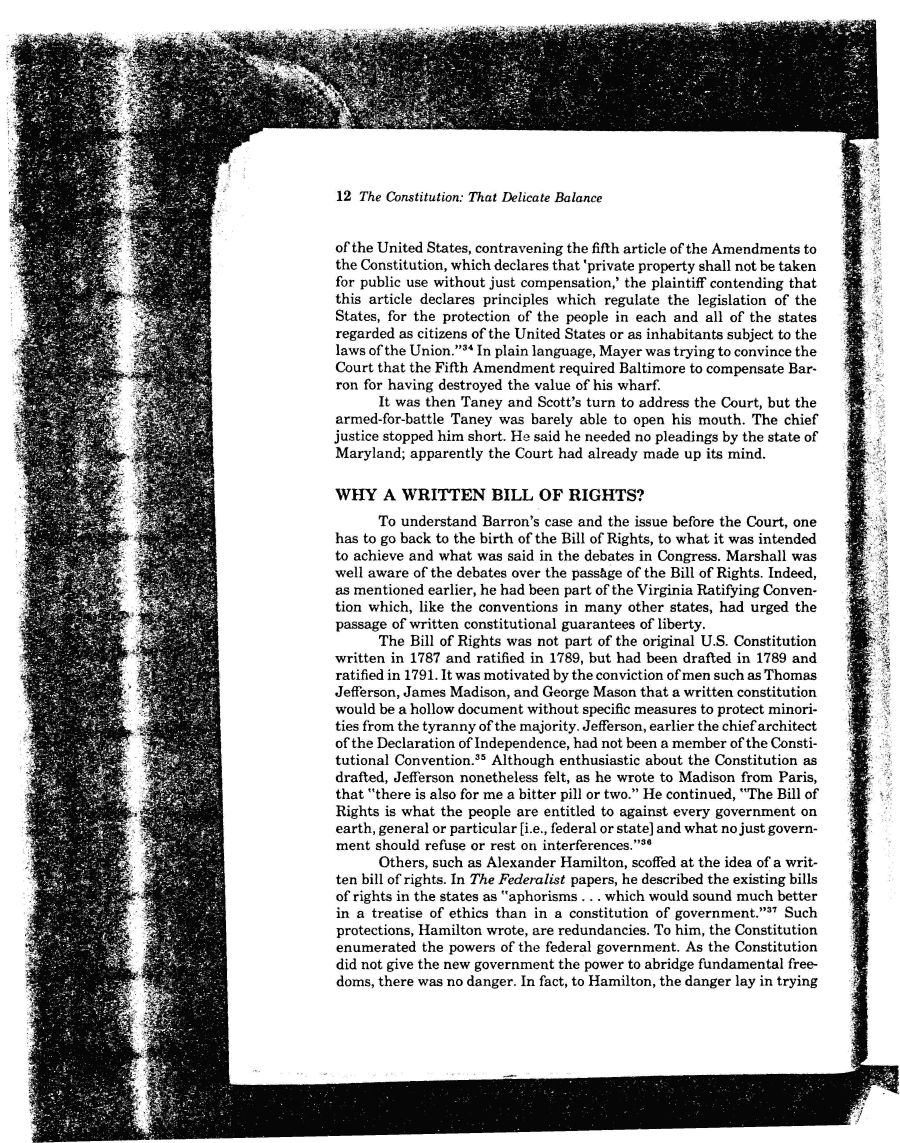|
12 The Constitution: That Delicate Balance
of the United States, contravening the fifth article of the Amendments to
the Constitution, which declares that 'private property shall not be taken
for public use without just compensation,' the plaintiff contending that
this article declares principles which regulate the legislation of the
States, for the protection of the people in each and all of the states
regarded as citizens of the United States or as inhabitants subject to the
laws of the Union."34 In plain language, Mayer was trying to convince the
Court that the Fifth Amendment required Baltimore to compensate Bar-
ron for having destroyed the value of his wharf.
It was then Taney and Scott's turn to address the Court, but the
armed-for-battle Taney was barely able to open his mouth. The chief
justice stopped him short. He said he needed no pleadings by the state of
Maryland; apparently the Court had already made up its mind.
WHY A WRITTEN BILL OF RIGHTS?
To understand Barren's case and the issue before the Court, one
has to go back to the birth of the Bill of Rights, to what it was intended
to achieve and what was said in the debates in Congress. Marshall was
well aware of the debates over the passage of the Bill of Rights. Indeed,
as mentioned earlier, he had been part of the Virginia Ratifying Conven-
tion which, like the conventions in many other states, had urged the
passage of written constitutional guarantees of liberty.
The Bill of Rights was not part of the original U.S. Constitution
written in 1787 and ratified in 1789, but had been drafted in 1789 and
ratified in 1791. It was motivated by the conviction of men such as Thomas
Jefferson, James Madison, and George Mason that a written constitution
would be a hollow document without specific measures to protect minori-
ties from the tyranny of the majority. Jefferson, earlier the chief architect
of the Declaration of Independence, had not been a member of the Consti-
tutional Convention.35 Although enthusiastic about the Constitution as
drafted, Jefferson nonetheless felt, as he wrote to Madison from Paris,
that "there is also for me a bitter pill or two." He continued, "The Bill of
Rights is what the people are entitled to against every government on
earth, general or particular [i.e., federal or state] and what no just govern-
ment should refuse or rest on interferences."36
Others, such as Alexander Hamilton, scoffed at the idea of a writ-
ten bill of rights. In The Federalist papers, he described the existing bills
of rights in the states as "aphorisms ... which would sound much better
in a treatise of ethics than in a constitution of government."37 Such
protections, Hamilton wrote, are redundancies. To him, the Constitution
enumerated the powers of the federal government. As the Constitution
did not give the new government the power to abridge fundamental free-
doms, there was no danger. In fact, to Hamilton, the danger lay in trying
|

